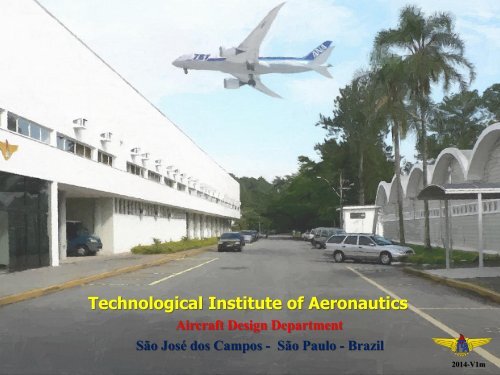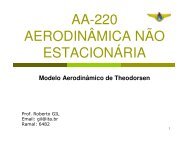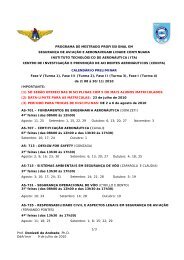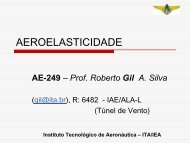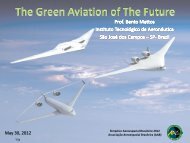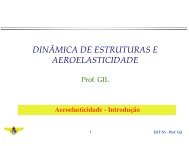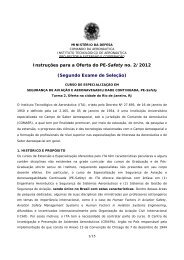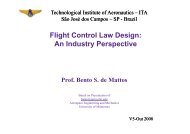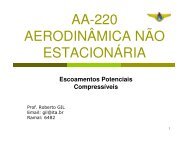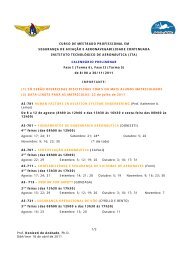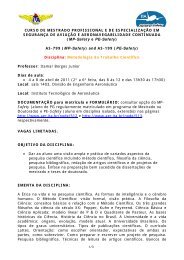Department of Aircraft Design - ITA
Department of Aircraft Design - ITA
Department of Aircraft Design - ITA
Create successful ePaper yourself
Turn your PDF publications into a flip-book with our unique Google optimized e-Paper software.
Technological Institute <strong>of</strong> Aeronautics<br />
<strong>Aircraft</strong> <strong>Design</strong> <strong>Department</strong><br />
São José dos Campos - São Paulo - Brazil<br />
2014-V1m
<strong>Aircraft</strong> <strong>Design</strong> <strong>Department</strong><br />
Content<br />
• Staff and facilities<br />
• Aerodynamics<br />
• Aeroacoustics<br />
• Airplane design framework<br />
• Integrated optimization (airplane+ airline network)<br />
• ANN application for aerodynamic coefficient<br />
• High-altitude Solar-powered UAV<br />
• New galley system concept
<strong>Aircraft</strong> <strong>Design</strong> <strong>Department</strong><br />
Staff and Facilities
<strong>Aircraft</strong> <strong>Design</strong> <strong>Department</strong><br />
Staff
<strong>Aircraft</strong> <strong>Design</strong> <strong>Department</strong><br />
Staff<br />
Industrial Experience – <strong>Aircraft</strong> <strong>Design</strong><br />
Coke-shaped<br />
rear fuselage<br />
Wing-fuselage fairing<br />
Wing planform
<strong>Aircraft</strong> <strong>Design</strong> <strong>Department</strong><br />
Staff<br />
Pr<strong>of</strong>essional experience with winglet design<br />
E-170/175<br />
EMB-145 SA<br />
ERJ 145XR<br />
Legacy 600/650
<strong>Aircraft</strong> <strong>Design</strong> <strong>Department</strong><br />
Staff<br />
Industrial Experience – <strong>Aircraft</strong> <strong>Design</strong>
<strong>Aircraft</strong> <strong>Design</strong> <strong>Department</strong><br />
Staff<br />
Industrial Experience – Flight Simulator
<strong>Aircraft</strong> <strong>Design</strong> <strong>Department</strong><br />
Facilities<br />
Virtual <strong>Aircraft</strong><br />
• Multi-disciplinary <strong>Design</strong> and Optimization<br />
• Computational Fluid Dynamics
<strong>Aircraft</strong> <strong>Design</strong> <strong>Department</strong><br />
Facilities<br />
Flight and Systems Simulation<br />
60 MHZ<br />
Simulation<br />
S<strong>of</strong>tware<br />
(X-Plane)<br />
Projection<br />
S<strong>of</strong>tware<br />
S<strong>of</strong>tware IG<br />
Simulation<br />
S<strong>of</strong>tware<br />
IOS
<strong>Aircraft</strong> <strong>Design</strong> <strong>Department</strong><br />
Facilities<br />
Flight and Systems Simulation<br />
1<br />
2<br />
3<br />
Spherical screen<br />
3<br />
Projection<br />
s<strong>of</strong>tware
<strong>Aircraft</strong> <strong>Design</strong> <strong>Department</strong><br />
Facilities<br />
Flight and Systems Simulation<br />
Beechcraft King Air
<strong>Aircraft</strong> <strong>Design</strong> <strong>Department</strong><br />
Facilities<br />
Flight and Systems Simulation – Helicopter Flight Simulator<br />
Thanks to Sikorsky Innovations support
<strong>Aircraft</strong> <strong>Design</strong> <strong>Department</strong><br />
Undergraduate Course – Airplanes designed by the students<br />
Class 2013 BWB 220-pax airliner<br />
Class 2012 220-pax airliner Eagle<br />
Class 2013 joined-wings 220-pax airliner<br />
Class 2011 220-pax airliner Copacabana
<strong>Aircraft</strong> <strong>Design</strong> <strong>Department</strong><br />
Aerodynamics
<strong>Aircraft</strong> <strong>Design</strong> <strong>Department</strong><br />
Fuselage design<br />
M ∞ = 0.60 α = 0 o
<strong>Aircraft</strong> <strong>Design</strong> <strong>Department</strong><br />
Fuselage design<br />
Mach number contours<br />
M ∞ = 0.85<br />
M ∞ = 0.85
<strong>Aircraft</strong> <strong>Design</strong> <strong>Department</strong><br />
Fuselage design<br />
Forward Fuselage Optimization for a 70-seater Airliner
<strong>Aircraft</strong> <strong>Design</strong> <strong>Department</strong><br />
System Integration<br />
High-Performance Computing<br />
Fuselage Aerodynamic Analysis<br />
Mach contours for the three ice-detector configurations calculated with CFD++ (M∞ = 0.76, α = 1.5 o )
<strong>Aircraft</strong> <strong>Design</strong> <strong>Department</strong><br />
System Integration<br />
Aerodynamic and Impingement Analysis<br />
Freestream Mach number = 0.76<br />
Ice droplet colliding with probe<br />
Local Mach number ≈ 2
<strong>Aircraft</strong> <strong>Design</strong> <strong>Department</strong><br />
Winglet <strong>Design</strong><br />
Aerodynamics analysis
<strong>Aircraft</strong> <strong>Design</strong> <strong>Department</strong><br />
Flow control<br />
Flow control Investigation<br />
Research on flow control by<br />
experimental investigation <strong>of</strong><br />
aerodynamic pr<strong>of</strong>ile with waveshaped<br />
leading and trailing edge<br />
at low Reynolds number
<strong>Aircraft</strong> <strong>Design</strong> <strong>Department</strong><br />
Aeroacoustics
<strong>Aircraft</strong> <strong>Design</strong> <strong>Department</strong><br />
Aeroacoustics<br />
Sound pressure levels above 80 dB<br />
M<br />
<br />
0.775 1.21<br />
0<br />
Ill-designed wing-fuselage fairing<br />
Simulations performed with the Fluent code<br />
Ice probe
<strong>Aircraft</strong> <strong>Design</strong> <strong>Department</strong><br />
System Integration<br />
Static Pressure Contours<br />
M<br />
<br />
0.45 1.5<br />
0<br />
Simulations performed with the Fluent code
<strong>Aircraft</strong> <strong>Design</strong> <strong>Department</strong><br />
System Integration<br />
M<br />
<br />
0.13 3 o
<strong>Aircraft</strong> <strong>Design</strong> <strong>Department</strong><br />
System Integration<br />
Broadband noise<br />
Nose landing gear
<strong>Aircraft</strong> <strong>Design</strong> <strong>Department</strong><br />
System Integration<br />
Broadband noise<br />
Main landing gear
<strong>Aircraft</strong> <strong>Design</strong> <strong>Department</strong><br />
Aeroacoustics<br />
Ramps and fairings to reduce LDG noise<br />
Powerflow
<strong>Aircraft</strong> <strong>Design</strong> <strong>Department</strong><br />
Aeroacoustics<br />
Fairing over wheel axis<br />
Noise reduction : 0.7 dB
<strong>Aircraft</strong> <strong>Design</strong> <strong>Department</strong><br />
Aeroacoustics<br />
Ramp<br />
Noise reduction : 1 dB
<strong>Aircraft</strong> <strong>Design</strong> <strong>Department</strong><br />
Airplane design<br />
Airplane Noise Modeling for Airplane Optimization<br />
• Noise estimation methods used for design optimization are:<br />
– Airframe noise: ESDU Data Sheets;<br />
– Engine: NASA interim reports;<br />
– Atmospheric attenuation: FAA<br />
• Methods were used in NASA’s ANOPP (<strong>Aircraft</strong> NOise Prediction Program),<br />
developed in the late 1970s from both experimental and theoretical data;<br />
• All the methods provide means to calculate SPLs for each <strong>of</strong> the 24<br />
standard frequencies (50 Hz to 10 kHz);<br />
• Airframe and Engine components’ SPLs are combined into Airplane SPLs;<br />
• Airplane SPLs are converted into EPNdBs;<br />
• Methods were coded and combined into a noise calculation unit called<br />
PANPA (Parametric Airliner Noise Prediction Architecture).
<strong>Aircraft</strong> <strong>Design</strong> <strong>Department</strong><br />
Airplane design<br />
Engine noise model:
<strong>Aircraft</strong> <strong>Design</strong> <strong>Department</strong><br />
Airplane design<br />
Airframe noise model:
<strong>Aircraft</strong> <strong>Design</strong> <strong>Department</strong><br />
Airplane design<br />
Overall Noise Estimation Validation<br />
Fly-over Sideline Approach<br />
Airplane Certified Estimated Error Certified Calculado Error Certified Estimated Error<br />
EPNdB EPNdB EPNdB EPNdB EPNdB EPNdB EPNdB EPNdB EPNdB<br />
B757-200 89.7 84.7 -5.0 94.2 93.7 -0.5 98.1 96.3 -1.8<br />
A320-200 83.9 82.3 -1.6 91.4 91.8 0.4 94.3 96.6 2.3<br />
DC-9-50 97.8 99.8 2.0 102.2 109.2 7.0 101.9 91.4 -10.5<br />
B767-300ER 89.9 85.4 -4.5 97.6 93.3 -4.3 97.7 89.9 -7.8<br />
A330-300 94.3 88.5 -5.8 98.3 96.1 -2.2 98.0 90.1 -7.9
<strong>Aircraft</strong> <strong>Design</strong> <strong>Department</strong><br />
Airplane Machine
<strong>Aircraft</strong> <strong>Design</strong> <strong>Department</strong><br />
Airplane design<br />
• May involve optimization <strong>of</strong> a given<br />
airline network<br />
• Flight quality considered as<br />
constraint<br />
Optimization<br />
algorithms<br />
DOE<br />
Airplane<br />
Machine<br />
Additional<br />
disciplines<br />
(ex.<br />
Aeroelasti<br />
city)<br />
Optimal<br />
airplanes<br />
• Contains already some optimizations inside in order to calculate<br />
airplane characteristics<br />
• Able to handle from subsonic to supersonic airplanes<br />
• May make use <strong>of</strong> metamodels for aerodynamic coefficients calculation<br />
or any other discipline<br />
• Must output noise signature and emission pr<strong>of</strong>ile
<strong>Aircraft</strong> <strong>Design</strong> <strong>Department</strong><br />
Airplane design<br />
• MATLAB® framework<br />
Airplane Machine<br />
• Transport aircraft only<br />
• Performance calculation<br />
• Configuration parameters (seating abreast; wing location, engine location, number <strong>of</strong> aisles, etc…)<br />
• Engine and airplane can be designed simultaneously<br />
• Noise signature and emission pr<strong>of</strong>ile<br />
• Wing airfoils design integration into current framework<br />
• Consideration <strong>of</strong> wingtip devices<br />
• Enable assessment <strong>of</strong> new technology<br />
• Tail surfaces designed by static and dynamic stability criteria (no tail volume coefficient employed)<br />
• Aeroelasticity <strong>of</strong> flexible wings (under development)
<strong>Aircraft</strong> <strong>Design</strong> <strong>Department</strong><br />
Airplane design<br />
Airplane Modeler - Fuselage<br />
- Variety <strong>of</strong> cross section (double deck, cargo compartment able to accommodate<br />
any sort <strong>of</strong> containers)<br />
- Windshield with single or double curvature<br />
- Assement <strong>of</strong> outside view area for the pilot<br />
- Variety <strong>of</strong> tail cone shapes
<strong>Aircraft</strong> <strong>Design</strong> <strong>Department</strong><br />
Airplane design<br />
Pace Cabin 7
<strong>Aircraft</strong> <strong>Design</strong> <strong>Department</strong><br />
Airplane design<br />
Pace Cabin 7
<strong>Aircraft</strong> <strong>Design</strong> <strong>Department</strong><br />
Airplane design<br />
Wing structural layout
<strong>Aircraft</strong> <strong>Design</strong> <strong>Department</strong><br />
Airplane design<br />
Structural Sizing (Megson’s Method)<br />
Airplane Actual Mass [kg] Calculated Mass [kg] Error [%]<br />
F28 3230 3120 3.53<br />
737-200 5000 5500 -9.09<br />
DC-9-30 5261 5050 4.18<br />
A319-100 8732 9360 -6.71<br />
A320-200 8766 9530 -8.02<br />
727-200 8956 9300 -3.70<br />
A321-200 10000 10500 -4.76<br />
Load calculation with BLWF
<strong>Aircraft</strong> <strong>Design</strong> <strong>Department</strong><br />
Airplane design<br />
Airplane Modeler
<strong>Aircraft</strong> <strong>Design</strong> <strong>Department</strong><br />
Airplane design
<strong>Aircraft</strong> <strong>Design</strong> <strong>Department</strong><br />
Airplane design<br />
BLWF Validation - Regional twinjet wing station<br />
Mach number = 0.775, Reynolds = 3.1·10 6 , AoA = 1.21 o
<strong>Aircraft</strong> <strong>Design</strong> <strong>Department</strong><br />
Airplane design<br />
<strong>Aircraft</strong> Stabilizer <strong>Design</strong> – MATLAB Tool<br />
Features<br />
• Roskam’s methodology for stability derivatives calculation<br />
• Static stability employed for design<br />
• VMCA and Dutch roll post analysis<br />
• Conventional or “T”-tail configurations<br />
• Extremely fast calculation
<strong>Aircraft</strong> <strong>Design</strong> <strong>Department</strong><br />
Airplane design<br />
<strong>Aircraft</strong> Stabilizer <strong>Design</strong> – MATLAB Tool<br />
VMCA
<strong>Aircraft</strong> <strong>Design</strong> <strong>Department</strong><br />
Airplane design<br />
<strong>Aircraft</strong> Stabilizer <strong>Design</strong> – MATLAB Tool
<strong>Aircraft</strong> <strong>Design</strong> <strong>Department</strong><br />
Airplane design<br />
<strong>Aircraft</strong> Stabilizer <strong>Design</strong> – MATLAB Tool<br />
Airplane<br />
HT area (m 2 ) VT area (m 2 )<br />
Calculated Actual Deviation (%) Calculated Actual<br />
Deviation (%)<br />
Boeing 757-200<br />
(RB211-535E4)<br />
52.06 50.35 +3.40 35.61 34.27 +3.91<br />
Fokker 100<br />
(R&R Tay 620)<br />
21.60 21.72 -0.55 12.28 12.30 -0.16<br />
Boeing 747-100<br />
(JT9D-7A)<br />
129.28 136.60 -5.35 77.99 77.10 +1.15<br />
Canadair CRJ-100ER<br />
(GE CF34-A)<br />
9.67 9.44 +2.44 9.73 9.18 +5.99<br />
Boeing 737-100<br />
(JT8D-7)<br />
19.46 20.81 -6.50 29.77 28.99 +2.70
<strong>Aircraft</strong> <strong>Design</strong> <strong>Department</strong><br />
Airplane design<br />
Engine module Validation<br />
Thrust @<br />
TO (lbf)<br />
SFC TO<br />
airflow<br />
TO<br />
(lb/s)<br />
Thrust<br />
@<br />
Cruise<br />
(lbf)<br />
Engine CPR Actual Data<br />
Manufacturer Bypass Engine Module<br />
Diameter (m) Error (%)<br />
SFC @<br />
Cruise<br />
Weight<br />
(lbf)<br />
CF6-45A 21 46500 - 1393 11250 0,63 8768<br />
GE 4,64 46221 - 1371 11223 0,60 9412<br />
2,2 -0.6% - -1.6% -0.2% -5.1% 7.3%<br />
PW2237 17 36600 - 1210 6500 0,58 7185<br />
Pratt Whitney 5,8 35180 - 1145 7400 0,59 6488<br />
2,01 -3.9% - -5.4% 13.8% 0.8% -9.7%<br />
CFM56-5A1 17 25000 0,33 852 5000 0,60 4995<br />
GE 6 25535 0,33 856 5351 0,60 4605<br />
1,73 2.1% 1.1% 0.5% 7.0% 0,3% -7.8%<br />
Tay 620 8 13850 - 410 - 0.69 3135<br />
Rolls Royce 3,04 14035 - 355 4575 0.65 2673<br />
1,118 1.3% - -13.4% - -5.7% -14.7%<br />
BR710A1-10 15 14750 0,39 435 - - 3520<br />
BMW / RR 4,2 14792 0,40 428 - - 2688<br />
1,23 0.3% 3.2% -1.6% - - -23.6%
<strong>Aircraft</strong> <strong>Design</strong> <strong>Department</strong><br />
Airplane design<br />
Engine module Validation<br />
Thrust @<br />
TO (lbf)<br />
SFC TO<br />
airflow<br />
TO<br />
(lb/s)<br />
Thrust<br />
@<br />
Cruise<br />
(lbf)<br />
Engine CPR Actual Data<br />
Manufacturer Bypass Engine Module<br />
Diameter (m) Error (%)<br />
SFC @<br />
Cruise<br />
Weight<br />
(lbf)<br />
CF6-45A 21 46500 - 1393 11250 0,63 8768<br />
GE 4,64 46221 - 1371 11223 0,60 9412<br />
2,2 -0.6% - -1.6% -0.2% -5.1% 7.3%<br />
PW2237 17 36600 - 1210 6500 0,58 7185<br />
Pratt Whitney 5,8 35180 - 1145 7400 0,59 6488<br />
2,01 -3.9% - -5.4% 13.8% 0.8% -9.7%<br />
CFM56-5A1 17 25000 0,33 852 5000 0,60 4995<br />
GE 6 25535 0,33 856 5351 0,60 4605<br />
1,73 2.1% 1.1% 0.5% 7.0% 0,3% -7.8%<br />
Tay 620 8 13850 - 410 - 0.69 3135<br />
Rolls Royce 3,04 14035 - 355 4575 0.65 2673<br />
1,118 1.3% - -13.4% - -5.7% -14.7%<br />
BR710A1-10 15 14750 0,39 435 - - 3520<br />
BMW / RR 4,2 14792 0,40 428 - - 2688<br />
1,23 0.3% 3.2% -1.6% - - -23.6%
<strong>Aircraft</strong> <strong>Design</strong> <strong>Department</strong><br />
Airplane design<br />
Airplane Machine
<strong>Aircraft</strong> <strong>Design</strong> <strong>Department</strong><br />
Airplane design<br />
APU<br />
Fuel System Architecture<br />
CHECK/RELIEF VALVE<br />
PRESSURE SWITCH<br />
SHUTOFF VALVE<br />
ELECTRICAL PUMP<br />
EJECTOR PUMP<br />
REFUELING ADAPTER<br />
BOOST PRESSURE<br />
REFUELING LINE<br />
EJECTOR PUMP OUTPUT
<strong>Aircraft</strong> <strong>Design</strong> <strong>Department</strong><br />
Airplane design<br />
Integration <strong>of</strong> PaceLab Suite
<strong>Aircraft</strong> <strong>Design</strong> <strong>Department</strong><br />
Airplane design<br />
Airplane Machine Validation<br />
Boeing 757-200<br />
Fokker 100 Standard<br />
Boeing 737-300<br />
Bombardier CRJ-200LR
<strong>Aircraft</strong> <strong>Design</strong> <strong>Department</strong><br />
Airplane design<br />
Airplane<br />
Fokker 100 Standard with<br />
R&R Tay 620 engines<br />
Airplane Machine Validation<br />
MTOW<br />
(kg)<br />
OEW<br />
(kg)<br />
MTOW (AA)<br />
(kg)<br />
OEW (AA)<br />
(kg)<br />
43,090 24,593 43,097 24,957<br />
Bombardier CRJ-200LR 24,154 13,835 24,011 14,238<br />
Boeing 737-300 with<br />
CFM56-3B1 engines<br />
56,473 31,480 55,491 31,121<br />
Boeing 757-200 115,650 62,100 115,501 59,544<br />
Airplane<br />
Fokker 100 Standard with<br />
R&R Tay 620<br />
MTOW Error<br />
(%)<br />
OEW Error<br />
(%)<br />
0 1.5<br />
Bombardier CRJ-200LR 0.6 2.3<br />
Boeing 737-300 with<br />
CFM5-3B1 engines<br />
1.7 1.1<br />
Boeing 757-200 0.12 4.1
<strong>Aircraft</strong> <strong>Design</strong> <strong>Department</strong><br />
Airliner Optimization with Noise and<br />
Emissions Considerations
<strong>Aircraft</strong> <strong>Design</strong> <strong>Department</strong><br />
Airplane design<br />
Long-range transcontinental jet (LRJ):<br />
– Requirements:<br />
• 250 passengers, single-aisle, single class, six abreast;<br />
• Range: 6,482km (3,500nm);<br />
• Minimum cruise altitude: 11,278m (37,000ft);<br />
• Cruise Mach number: M0.80;<br />
• TOFL @ MTOW ≤ 2,500m;<br />
• LFL @ MLW ≤ 2,500m;<br />
• Maximum Payload: 24,000kg;<br />
• Maximum Usable Fuel: 34,000kg.
<strong>Aircraft</strong> <strong>Design</strong> <strong>Department</strong><br />
Airplane design<br />
LRJA – DOC-optimized design:<br />
Parameter<br />
Value<br />
Wing area (m 2 ) 180.0<br />
Wing sweep<br />
29.71 o<br />
Wing aspect ratio 11.29<br />
Wing taper ratio 0.202<br />
Wing crank position 27.5<br />
Horizontal tail aspect ratio 6.000<br />
Flap deflection, take<strong>of</strong>f 6.4<br />
Engine by-pass ratio 6.49<br />
Engine fan diameter (m) 1.856<br />
Engine overall pressure ratio 35.0
<strong>Aircraft</strong> <strong>Design</strong> <strong>Department</strong><br />
Airplane design<br />
LRJB – Noise-optimized design:<br />
Parameter<br />
Value<br />
Wing area (m 2 ) 180.0<br />
Wing sweep<br />
26.70 o<br />
Wing aspect ratio 11.18<br />
Wing taper ratio 0.283<br />
Wing crank position 20.5<br />
Horizontal tail aspect ratio 5.993<br />
Flap deflection, take<strong>of</strong>f 5.4<br />
Engine by-pass ratio 6.43<br />
Engine fan diameter (m) 2.000<br />
Engine overall pressure ratio 35.0
<strong>Aircraft</strong> <strong>Design</strong> <strong>Department</strong><br />
Airplane design<br />
LRJC – NO X -optimized design:<br />
Parameter<br />
Final value<br />
Wing area (m 2 ) 182.7<br />
Wing sweep<br />
34.79 o<br />
Wing aspect ratio 9.21<br />
Wing taper ratio 0.244<br />
Wing crank position 27.3<br />
Horizontal tail aspect ratio 5.770<br />
Flap deflection, take<strong>of</strong>f 27.6<br />
Engine by-pass ratio 5.60<br />
Engine fan diameter (m) 1.780<br />
Engine overall pressure ratio 25.0
<strong>Aircraft</strong> <strong>Design</strong> <strong>Department</strong><br />
Airplane design<br />
LRJ – all:<br />
Parameter Unit LRJA<br />
(DOC)<br />
LRJB<br />
(Noise)<br />
LRJC<br />
(Emission)<br />
MTOW kg 102,868 101,916 104,339<br />
Fuel for 3,500nm kg 26,085 25,850 26,507<br />
Rated take<strong>of</strong>f thrust kN 140.3 163.0 144.6<br />
DOC US$/km 9.73 10.17 10.69<br />
Fly-over noise EPNdB 81.0 75.0 82.5<br />
Sideline noise EPNdB 87.6 88.5 88.4<br />
Approach noise EPNdB 89.6 88.3 90.1<br />
LTO NOX emissions kg 1.528 1.497 0.818
<strong>Aircraft</strong> <strong>Design</strong> <strong>Department</strong><br />
Airplane design<br />
Cumulative Noise Reduction [EPNdB]<br />
Relative LTO NOx<br />
LRJ – two-objective optimization:<br />
0.5<br />
0<br />
-0.5<br />
-1<br />
LRJ Two-objetive Optimization - Pareto front<br />
100 gen<br />
150 gen<br />
200 gen<br />
250 gen<br />
300 gen<br />
1.05<br />
1<br />
0.95<br />
LRJ Two-objetive Optimization - Pareto front<br />
100 gen<br />
150 gen<br />
200 gen<br />
250 gen<br />
300 gen<br />
-1.5<br />
0.9<br />
-2<br />
0.85<br />
-2.5<br />
-3<br />
-3.5<br />
-4<br />
-4.5<br />
-5<br />
-5.5<br />
-6<br />
-6.5<br />
-7<br />
0.96 0.98 1 1.02 1.04 1.06<br />
Relative DOC<br />
0.8<br />
0.75<br />
0.7<br />
0.65<br />
0.6<br />
0.55<br />
0.5<br />
0.45<br />
0.99 1 1.01 1.02 1.03 1.04 1.05 1.06 1.07<br />
Relative DOC
<strong>Aircraft</strong> <strong>Design</strong> <strong>Department</strong><br />
Airplane design<br />
• LRJ – three-objective optimization:
<strong>Aircraft</strong> <strong>Design</strong> <strong>Department</strong><br />
Airplane design<br />
Mid-range Regional Jet (MRJ):<br />
Requirements:<br />
100 passengers, single-aisle, single class, four abreast;<br />
Range: 3,704km (2,000nm);<br />
Minimum cruise altitude: 11,887m (39,000ft);<br />
Cruise Mach number: M0.80;<br />
TOFL @ MTOW ≤ 1,800m;<br />
LFL @ MLW ≤ 1,800m;<br />
Maximum Payload: 13,500kg;<br />
Maximum usable fuel: 13,000kg.
<strong>Aircraft</strong> <strong>Design</strong> <strong>Department</strong><br />
Airplane design<br />
Mid-range Regional Jet (MRJ)<br />
Critical design constraints:<br />
Parameter Unit Min value Max value<br />
Wing area m² 80.0 100.0<br />
Wing sweep deg 18.0 35.0<br />
Wing aspect ratio - 6.0 12.0<br />
Wing taper ratio - 0.20 0.30<br />
Wing crank position % 20.0 40.0<br />
Horizontal tail aspect ratio - 3.0 6.0<br />
Flap deflection, take<strong>of</strong>f deg 5.0 30.0<br />
Engine by-pass ratio - 3.5 5.5<br />
Engine fan diameter m 1.200 1.500<br />
Engine overall pressure ratio - 20.0 30.0
<strong>Aircraft</strong> <strong>Design</strong> <strong>Department</strong><br />
Airplane design<br />
MRJA – DOC-optimized design:<br />
Parameter<br />
Final value<br />
Wing area (m 2 ) 80.0<br />
Wing sweep<br />
28.53 o<br />
Wing aspect ratio 11.52<br />
Wing taper ratio 0.215<br />
Wing crank position 28.5<br />
Horizontal tail aspect ratio 5.998<br />
Flap deflection, take<strong>of</strong>f 7.4<br />
Engine by-pass ratio 5.50<br />
Engine fan diameter (m) 1.203<br />
Engine overall pressure ratio 29.6
<strong>Aircraft</strong> <strong>Design</strong> <strong>Department</strong><br />
Airplane design<br />
MRJB – Noise-optimized design:<br />
Parameter<br />
Final value<br />
Wing area (m 2 ) 82.9<br />
Wing sweep<br />
21.34 o<br />
Wing aspect ratio 11.10<br />
Wing taper ratio 0.278<br />
Wing crank position 20.5<br />
Horizontal tail aspect ratio 3.186<br />
Flap deflection, take<strong>of</strong>f 5.0<br />
Engine by-pass ratio 5.50<br />
Engine fan diameter (m) 1.457<br />
Engine overall pressure ratio 28.95
<strong>Aircraft</strong> <strong>Design</strong> <strong>Department</strong><br />
Airplane design<br />
MRJC – NO X -optimized design:<br />
Parameter<br />
Final value<br />
Wing area (m 2 ) 93.92<br />
Wing sweep<br />
31.31 o<br />
Wing aspect ratio 6.93<br />
Wing taper ratio 0.299<br />
Wing crank position 31.8<br />
Horizontal tail aspect ratio 5.076<br />
Flap deflection, take<strong>of</strong>f 22.1<br />
Engine by-pass ratio 5.47<br />
Engine fan diameter (m) 1.200<br />
Engine overall pressure ratio 20.0
<strong>Aircraft</strong> <strong>Design</strong> <strong>Department</strong><br />
Airplane design<br />
MRJ – all:<br />
Parameter Unit LRJA<br />
(DOC)<br />
LRJB<br />
(Noise)<br />
LRJC<br />
(Emission)<br />
MTOW kg 38,195 38,377 42,288<br />
Fuel for 2,000nm kg 9,657 9,702 10,716<br />
Rated take<strong>of</strong>f thrust kN/eng 67.9 98.2 67.2<br />
DOC US$/km 4.89 5.30 5.60<br />
Fly-over noise EPNdB 72.0 68.2 76.6<br />
Sideline noise EPNdB 84.4 84.9 84.7<br />
Approach noise EPNdB 85.6 84.0 85.7<br />
LTO NOX emissions kg 0.495 0.697 0.286
<strong>Aircraft</strong> <strong>Design</strong> <strong>Department</strong><br />
Airplane design<br />
Cumulative Noise Reduction [EPNdB]<br />
Relative LTO NOx<br />
MRJ – two-objective optimization:<br />
1<br />
0.5<br />
0<br />
MRJ Two-objetive Optimization - Pareto front<br />
100 gen<br />
150 gen<br />
200 gen<br />
250 gen<br />
300 gen<br />
1.05<br />
1<br />
MRJ Two-objetive Optimization - Pareto front<br />
100 gen<br />
150 gen<br />
200 gen<br />
250 gen<br />
300 gen<br />
-0.5<br />
0.95<br />
-1<br />
0.9<br />
-1.5<br />
-2<br />
0.85<br />
-2.5<br />
0.8<br />
-3<br />
0.75<br />
-3.5<br />
0.7<br />
-4<br />
0.65<br />
-4.5<br />
0.6<br />
-5<br />
-5.5<br />
0.96 0.98 1 1.02 1.04 1.06 1.08 1.1 1.12<br />
Relative DOC<br />
0.55<br />
0.5<br />
0.99 1 1.01 1.02 1.03 1.04 1.05 1.06 1.07 1.08 1.09 1.1 1.11 1.12 1.13 1.14 1.15 1.16<br />
Relative DOC
<strong>Aircraft</strong> <strong>Design</strong> <strong>Department</strong><br />
Airplane design<br />
• MRJ – three-objective<br />
Test cases and<br />
optimization:<br />
results
<strong>Aircraft</strong> <strong>Design</strong> <strong>Department</strong><br />
Network-airplane Integrated <strong>Design</strong>
<strong>Aircraft</strong> <strong>Design</strong> <strong>Department</strong><br />
Airplane design<br />
Usual approach:<br />
Integrated <strong>Design</strong><br />
• Airplane design for a given typical mission<br />
or<br />
• Network optimization for existing airplanes
<strong>Aircraft</strong> <strong>Design</strong> <strong>Department</strong><br />
Airplane design<br />
Methodology<br />
• Based on Christine Taylor (MIT) PhD Thesis.<br />
• Three different design cases were carried out:<br />
– Case I: airline network only<br />
– Case I: airplane optimization only<br />
– Case III: integrated design (airline network + airplane)
<strong>Aircraft</strong> <strong>Design</strong> <strong>Department</strong><br />
Airplane integrated design<br />
Transportation System Modeling<br />
Objective<br />
Operating cost minimization<br />
Airplane<br />
• Performance<br />
• Constraints<br />
• Direct Operating Cost (DOC)<br />
Airline network<br />
• Allocation <strong>of</strong> airplanes / cargo<br />
• Demand constraints<br />
• Noise regulations<br />
• Availble airport runway<br />
Operational constraints<br />
• Route operation<br />
• Cargo/passenger capacity
<strong>Aircraft</strong> <strong>Design</strong> <strong>Department</strong><br />
Comparative study with rotorcraft vehicles<br />
IBM CPLEX<br />
The CPLEX solver from IBM ILOG is a high performance solver for Linear<br />
Programming (LP), Mixed Integer Programming (MIP) and Quadratic Programming<br />
(QP/QCP/MIQP/MIQCP) problems.
<strong>Aircraft</strong> <strong>Design</strong> <strong>Department</strong><br />
Airplane integrated design<br />
Implementation <strong>of</strong> Case I<br />
• Only network optimization (Cargo airplane allocation)<br />
• Three existing airplanes are available<br />
Restrições:<br />
A ∙ x ≤ b<br />
A eq ∙ x = b eq<br />
lb ≤ x ≤ ub<br />
Perturba<br />
x<br />
Não<br />
Mínimo<br />
CPLEX<br />
Sim<br />
n ik<br />
A<br />
n ik<br />
B<br />
n ik<br />
C<br />
Calcula<br />
f(x)<br />
x ijk<br />
Dados<br />
r A<br />
w A<br />
v A<br />
Determina<br />
custo por rota<br />
DOC ik<br />
A
<strong>Aircraft</strong> <strong>Design</strong> <strong>Department</strong><br />
Airplane integrated design<br />
Case II<br />
• Consider airplane optimization only<br />
• Hub-Spoke network<br />
Restrições:<br />
lb ≤ x ≤ ub<br />
Perturba<br />
x<br />
r<br />
w<br />
v<br />
Determina<br />
custo por rota<br />
DOC ik<br />
Calcula<br />
n ik<br />
RS = Simulated annealing<br />
AG = Genetic algorithm<br />
Não<br />
Mínimo<br />
Calcula<br />
f(x)<br />
RS ou AG<br />
Sim
<strong>Aircraft</strong> <strong>Design</strong> <strong>Department</strong><br />
Airplane integrated design<br />
Case III - Integrated optimization (airline network and airplane)<br />
Restrições:<br />
lb ≤ x 1 ≤ ub<br />
Perturba<br />
x 1<br />
Não<br />
Mínimo<br />
RS ou AG<br />
Sim<br />
RS = Simulated annealing<br />
AG = Genetic algorithm<br />
r<br />
w<br />
v<br />
Determina<br />
custo por rota<br />
DOC ik<br />
Restrições:<br />
A ∙ x 2 ≤ b<br />
A eq ∙ x 2 = b eq<br />
lb ≤ x 2 ≤ ub<br />
Perturba<br />
x 2<br />
Não<br />
Mínimo<br />
n ik<br />
Calcula<br />
x ijk f(x 2 )<br />
CPLEX<br />
Sim
<strong>Aircraft</strong> <strong>Design</strong> <strong>Department</strong><br />
Airplane integrated design<br />
Four networks (Examples):<br />
– First Seven USA cities (alphabetical order)<br />
– Seven USA cities considering cargo transportation rank<br />
– Seven Brazilian cities considering a rank in cargo transportation<br />
– Five Brazilian Southwest cities ranked in cargo transportation
<strong>Aircraft</strong> <strong>Design</strong> <strong>Department</strong><br />
Airplane integrated design<br />
• Example 1 – First seven cities in USA<br />
Distance (nm)<br />
Demand (lb)<br />
ABQ ATL BOS CLT ORD CVG CLE<br />
ABQ 0 1.222 1.933 1.426 1.160 1.209 1.393<br />
ATL 1.222 0 934 208 622 400 619<br />
BOS 1.933 934 0 731 882 755 563<br />
CLT 1.426 208 731 0 682 423 448<br />
ORD 1.160 622 882 682 0 260 309<br />
CVG 1.209 400 755 423 260 0 219<br />
CLE 1.393 619 563 448 309 219 0<br />
ABQ ATL BOS CLT ORD CVG CLE<br />
ABQ 0 2.356 2.051 673 4.572 214 747<br />
ATL 2.356 0 14.045 4.610 31.313 1.465 5.112<br />
BOS 2.051 14.045 0 4.014 27.261 1.276 4.451<br />
CLT 673 4.610 4.014 0 8.948 419 1.461<br />
ORD 4.572 31.313 27.261 8.948 0 2.844 9.923<br />
CVG 214 1.465 1.276 419 2.844 0 464<br />
CLE 747 5.112 4.451 1.461 2.844 464 0
<strong>Aircraft</strong> <strong>Design</strong> <strong>Department</strong><br />
Airplane integrated design<br />
• Example 2 – Seven major USA cities<br />
Distance (nm)<br />
Demand (lb)<br />
ATL BOS ORD DFW LAX JFK SFO<br />
ATL BOS ORD DFW LAX JFK SFO<br />
ATL 0 934 622 688 1.921 756 2.179<br />
BOS 934 0 882 1.538 2.629 183 2.729<br />
ORD 622 882 0 806 1.767 713 1.866<br />
DFW 688 1.538 806 0 1.257 1.360 1.518<br />
LAX 1.921 2.629 1.767 1.257 0 2.454 330<br />
JFK 756 183 713 1.360 2.454 0 2.560<br />
ATL 0 14.045 31.313 19.984 34.506 57.949 37.318<br />
BOS 14.045 0 27.261 17.398 30.041 50.451 32.489<br />
ORD 31.313 27.261 0 38.788 66.975 112.479 72.434<br />
DFW 19.984 17.398 38.788 0 42.743 71.784 46.227<br />
LAX 34.506 30.041 66.975 42.743 0 123.948 79.820<br />
JFK 57.949 50.451 112.479 71.784 123.948 0 134.050<br />
SFO 2.179 2.729 1.866 1.518 330 2.560 0<br />
SFO 37.318 32.489 72.434 46.227 79.820 134.050 0
<strong>Aircraft</strong> <strong>Design</strong> <strong>Department</strong><br />
Airplane integrated design<br />
Example 3 – Seven major Brazilian cities<br />
Distance (nm)<br />
Demand (lb)<br />
SAO MAO REC SSA FOR BSB POA<br />
SAO 0 1.455 1.133 783 1.266 461 467<br />
MAO 1.455 0 1.530 1.418 1.289 1.051 1.694<br />
REC 1.133 1.530 0 350 339 893 1.598<br />
SSA 783 1.418 350 0 548 585 1.248<br />
FOR 1.266 1.289 339 548 0 913 1.728<br />
BSB 461 1.051 893 585 913 0 866<br />
POA 467 1.694 1.598 1.248 1.728 866 0<br />
SAO MAO REC SSA FOR BSB POA<br />
SAO 0 308.265 81.729 80.121 72.325 83.878 42.697<br />
MAO 308.265 0 7.598 13.010 18.557 34.056 663<br />
REC 81.729 7.598 0 12.024 32.524 13.452 4.043<br />
SSA 80.121 13.010 12.024 0 13.046 11.711 1.037<br />
FOR 72.325 18.557 32.524 13.046 0 12.126 1.599<br />
BSB 83.878 34.056 13.452 11.711 12.126 0 6.814<br />
POA 42.697 663 4.043 1.037 1.599 6.814 0
<strong>Aircraft</strong> <strong>Design</strong> <strong>Department</strong><br />
Airplane integrated design<br />
Example 4 – 5 major Southeast Brazilian cities<br />
Distance (nm)<br />
Demand (lb)<br />
SAO CNF RIO VIX VCP<br />
SAO 0 267 182 394 45<br />
CNF 267 0 195 213 269<br />
RIO 182 195 0 225 215<br />
VIX 394 213 225 0 417<br />
VCP 45 269 215 417 0<br />
SAO CNF RIO VIX VCP<br />
SAO 0 25.702 40.875 11.691 1.431<br />
CNF 25.702 0 4.598 1.336 3.681<br />
RIO 40.875 4.598 0 8.989 4.247<br />
VIX 11.691 1.336 8.989 0 4.869<br />
VCP 1.431 3.681 4.247 4.869 0
<strong>Aircraft</strong> <strong>Design</strong> <strong>Department</strong><br />
Airplane integrated design<br />
Results – Case I (network optimization)<br />
• Airplanes for Examples 1 and 2<br />
Parameter<br />
Airplane A Airplane B Airplane C<br />
Fairchild Expediter B757-200F MD11F<br />
Payload (lb) 5.000 72.210 202.100<br />
Range (nm) 1.063 3.000 3.950<br />
Speed (kt) 252 465 526<br />
• Airplanes for Examples 3 and 4<br />
Parameter<br />
Airplane A Airplane B Airplane C<br />
Cessna Caravan<br />
208A<br />
(Cargomaster)<br />
B727-200F<br />
DC10-30F<br />
Payload (lb) 3.000 58.000 152.964<br />
Range (nm) 1.115 2.140 3.100<br />
Speed (kt) 184 515 490
<strong>Aircraft</strong> <strong>Design</strong> <strong>Department</strong><br />
Airplane integrated design<br />
Results – Case I<br />
Same network as those found by Taylor<br />
Airplane A Airplane B Airplane C<br />
Related airplane Fairchild Expediter B757-200F MD11F<br />
Example 1 Example 2<br />
C. Taylor $ 107.888,00 $ 517.030,00<br />
Present work $ 107.869,54 $ 516.967,72<br />
Difference -0,02% -0,01%<br />
Payload (lb) 5,000 72,210 202,100<br />
Range (nm) 1,063 3,000 3,950<br />
Speed (kts) 252 465 526<br />
Fixed cost<br />
(US$/day)<br />
Variable cost<br />
(US$/h)<br />
1,481 10,616 26,129<br />
758 3,116 7,194
<strong>Aircraft</strong> <strong>Design</strong> <strong>Department</strong><br />
Airplane integrated design<br />
Example 1<br />
• Total cost: $ 143,046.84<br />
Results – Case I
<strong>Aircraft</strong> <strong>Design</strong> <strong>Department</strong><br />
Airplane integrated design<br />
Example 2<br />
• Total cost: $ 854,686.76<br />
Results – Case I
<strong>Aircraft</strong> <strong>Design</strong> <strong>Department</strong><br />
Airplane design<br />
Example 3<br />
• Total cost: $ 439,676.69<br />
Results – Case I
<strong>Aircraft</strong> <strong>Design</strong> <strong>Department</strong><br />
Airplane design<br />
Example I<br />
• Total cost: $ 45,635.00<br />
Results – Case I
<strong>Aircraft</strong> <strong>Design</strong> <strong>Department</strong><br />
Airplane design<br />
Example 4<br />
• Total cost: $ 45,635.00<br />
Results – Case I
<strong>Aircraft</strong> <strong>Design</strong> <strong>Department</strong><br />
Airplane design<br />
Results – Case II<br />
Example 1<br />
Parâmetro AG RS<br />
Carga paga w (lbs) 28.374,18 28.287,00<br />
Alcance r (nm) 1.259,20 1.222,00<br />
Velocidade v (kts) 549,48 550,00<br />
Custo mínimo ($) 82.123,11 81.501,64<br />
1 − Caso2 Caso1 42,59% 43,02%
<strong>Aircraft</strong> <strong>Design</strong> <strong>Department</strong><br />
Airplane design<br />
Results – Caso II<br />
Example 2<br />
Parameter<br />
Genetic<br />
algorithm<br />
Simulated<br />
annealing<br />
Payload (lb) 201,341.55 201,171.50<br />
Range r (nm) 1,866 1,866<br />
Speed v (kts) 549 550<br />
Minimum cost ($) 767,945.4 766,558.4<br />
1 – Case II/Case I 10.15 % 10.31 %
<strong>Aircraft</strong> <strong>Design</strong> <strong>Department</strong><br />
Airplane design<br />
Results – Case II<br />
Example 3<br />
Parameter<br />
Genetic<br />
algorithm<br />
Simulated<br />
annealing<br />
Payload (lb) 76,565 76,462<br />
Range r (nm) 1,517.65 1,455.00<br />
Speed v (kts) 548.8 550<br />
Minimum cost ($) 412,294,3 408,068,7<br />
1 – Case II/Case I 6.23 % 7.19 %
<strong>Aircraft</strong> <strong>Design</strong> <strong>Department</strong><br />
Airplane design<br />
Results – Case II<br />
Example 4<br />
Parameter<br />
Genetic<br />
algorithm<br />
Simulated<br />
annealing<br />
Payload (lb) 35,500 35,317<br />
Range r (nm) 1,000 1,000<br />
Speed v (kts) 549.3 550<br />
Minimum cost ($) 32,079.39 31,925.12<br />
1 – Case II/Case I 29.70 % 30.04 %
<strong>Aircraft</strong> <strong>Design</strong> <strong>Department</strong><br />
Airplane design<br />
Results – Case III<br />
Exemplo 1<br />
Parâmetro AG RS<br />
Carga paga w (lbs) 18.308,10 9.713,50<br />
Alcance r (nm) 1.161,98 1.222,08<br />
Velocidade v (kts) 545,95 550,00<br />
Custo mínimo ($) 66.714,75 67.728,30<br />
1 − Caso3 Caso2 18,76% 16,90%<br />
1 − Caso3 Caso1 53,36% 52,65%
<strong>Aircraft</strong> <strong>Design</strong> <strong>Department</strong><br />
Airplane design<br />
Results – Caso III<br />
Example 2<br />
Parâmetro AG RS<br />
Carga paga w (lbs) 126.169,66 131.972,55<br />
Alcance r (nm) 2.011,72 1.921,00<br />
Velocidade v (kts) 527,52 550,00<br />
Custo mínimo ($) 698.333,29 676.808,26<br />
1 − Caso3 Caso2 9,06% 11,71%<br />
1 − Caso3 Caso1 18,29% 20,81%
<strong>Aircraft</strong> <strong>Design</strong> <strong>Department</strong><br />
Airplane design<br />
Example 3<br />
Results – Case III<br />
Parameter<br />
Genetic<br />
algorithm<br />
Simulated<br />
annealing<br />
Payload (lb) 56,975 65,808<br />
Range r (nm) 1,522 1,455<br />
Speed v (kts) 548 550<br />
Minimum cost ($) 387,308.86 373,780.11<br />
1 – Case III/Case II 6.06 % 8.40 %<br />
1- Case III/Case I 11.91 % 14.99 %
<strong>Aircraft</strong> <strong>Design</strong> <strong>Department</strong><br />
Airplane design<br />
Results – Case III<br />
Example 4<br />
Parameter<br />
Genetic<br />
Algorithm<br />
Simulated<br />
annealing<br />
Payload (lb) 14,769 14,228<br />
Range r (nm) 1,000 1,000<br />
Speed v (kts) 545 550<br />
Minimum cost ($) 29,290.71 28,354.80<br />
1 – Case III/Case II 8.69 % 11.18 %<br />
1 – Case III/Case I 35.82 % 37.87 %
<strong>Aircraft</strong> <strong>Design</strong> <strong>Department</strong><br />
Airplane design<br />
Efficiency metrics<br />
• Utilization <strong>of</strong> available cargo capacity:<br />
N<br />
N<br />
N<br />
N<br />
N<br />
i cap /carga =<br />
x ijk<br />
2 n ik w<br />
i=1<br />
j =1 k=1<br />
i=1<br />
k=1<br />
• Utilization <strong>of</strong> available range:<br />
N<br />
N<br />
N<br />
N<br />
i cap /prop =<br />
n ik D ik<br />
n ik r<br />
i=1<br />
k=1<br />
i=1<br />
k=1
<strong>Aircraft</strong> <strong>Design</strong> <strong>Department</strong><br />
Airplane design<br />
Network No. 1 Network No. 2<br />
i cap/carga<br />
i cap/prop<br />
i cap/carga<br />
i cap/prop<br />
Caso 1 47% 32%<br />
Caso 2 - AG 50% 55%<br />
Caso 2 - RS 50% 56%<br />
Caso 3 - AG 64% 53%<br />
Caso 3 - RS 73% 54%<br />
Caso 1 73% 30%<br />
Caso 2 - AG 52% 61%<br />
Caso 2 - RS 52% 61%<br />
Caso 3 - AG 65% 55%<br />
Caso 3 - RS 62% 57%<br />
Network No. 3 Network No. 4<br />
i cap/carga<br />
i cap/prop<br />
i cap/carga<br />
i cap/prop<br />
Caso 1 79% 40%<br />
Caso 2 - AG 74% 68%<br />
Caso 2 - RS 70% 73%<br />
Caso 3 - AG 79% 62%<br />
Caso 3 - RS 81% 68%<br />
Caso 1 57% 10%<br />
Caso 2 - AG 61% 21%<br />
Caso 2 - RS 61% 21%<br />
Caso 3 - AG 81% 23%<br />
Caso 3 - RS 84% 23%
<strong>Aircraft</strong> <strong>Design</strong> <strong>Department</strong><br />
Airplane integrated design<br />
Integrated <strong>Design</strong> Remarks<br />
• Redução no custo total alcançado, com mínimo de 6%.<br />
• Limitações devido à simplificação dos modelos.<br />
• Limitações computacionais para modelos mais complexos.
<strong>Aircraft</strong> <strong>Design</strong> <strong>Department</strong><br />
Airplane design<br />
<strong>Design</strong> Parameters<br />
• Wing washout angle: -3 o<br />
• Seat width: 0.46 m<br />
• Wing break station positioning: placed at 35% semispan<br />
• Aisle width: 0.48 m<br />
• HT sweepback angle = wing sweepback angle + 5 o<br />
• Landing flap deflection: 45 o<br />
• Take<strong>of</strong>f flap deflection: 8 o<br />
• VT aspect ratio: 1.6<br />
• VT quarter chord sweepback angle: 35 o<br />
• VT taper ratio: 0.50<br />
• Service ceiling: 41,000 ft<br />
• Wing dihedral angle: 2.5 o<br />
• MMO: 0.82<br />
• Turbine inlet temperature: 1450 K<br />
• Fuel for 100 nm alternate destination + 45 min holding<br />
• JetA1 gallon price: US$ 3.28
<strong>Aircraft</strong> <strong>Design</strong> <strong>Department</strong><br />
Airplane integrated design<br />
<strong>Design</strong> Variables<br />
• Wing aspect ratio<br />
• Wing taper ratio<br />
• Wing reference area<br />
• Wing quarter-chord sweepback angle<br />
• Maximum relative wing thickness at root<br />
• Maximum relative wing thickness at tip<br />
• Seating abreast<br />
• Number <strong>of</strong> corridors<br />
• Number <strong>of</strong> engines<br />
• Engine location<br />
• Tail configuration<br />
• Wing location<br />
• HT taper ratio<br />
• VT reference area<br />
• HT volume coefficient<br />
• Fan diameter<br />
• Engine by-pass ratio<br />
• Engine overall pressure ratio<br />
• Fan pressure ratio
<strong>Aircraft</strong> <strong>Design</strong> <strong>Department</strong><br />
Airplane integrated design<br />
Integrated <strong>Design</strong> (Network + Airliner)<br />
Brazilian (very) Small Network<br />
1<br />
CNF<br />
1<br />
VIX<br />
1<br />
1<br />
1<br />
2<br />
GIG<br />
VCP<br />
1<br />
GRU<br />
Total: 8 airplanes<br />
Simulations carried-out with MATLAB ® and IBM ® CPLEX
<strong>Aircraft</strong> <strong>Design</strong> <strong>Department</strong><br />
Airplane integrated design<br />
Network + Airplane<br />
Optimal<br />
airplane<br />
Boeing 737-800<br />
CFM56-7B24<br />
MTOW<br />
(kg)<br />
Seating<br />
capacity<br />
(single<br />
class)<br />
Seating<br />
abreast<br />
Range with<br />
max.<br />
payload<br />
(nm)<br />
MMO<br />
Wing area<br />
(m 2 )<br />
AR W<br />
Wing<br />
sweepback<br />
angle<br />
(degrees)<br />
61,500 191 6 1,185 + 0.78 129.6 10.47 29.90<br />
70,534 α 184 6 700 * 0.82 124.6 9.45 25.0<br />
(without winglets)<br />
Optimal<br />
Airplane<br />
Boeing 737-800<br />
CFM56-7B24<br />
Fan<br />
diameter<br />
(m)<br />
BPR OPR FPR AR HT<br />
HT<br />
sweepback<br />
angle<br />
(degrees)<br />
1.7 6.3 30 1.73 4.37 29.9<br />
1.55 5.3 32.8 unknown 6.16 30.0<br />
Brazilian Small Network<br />
Central<br />
fuselage<br />
diameter<br />
(m)<br />
Circular<br />
3.85<br />
Elliptical<br />
3.76 wide<br />
4.01 tall<br />
(without winglets)<br />
α Boeing 737-800 basic version. Boeing also <strong>of</strong>fers a 79 t version presenting a 2200-nm range with maximum payload. The latter delivers a range<br />
<strong>of</strong> 1,100 nm with 72.9 t TOW.<br />
+ Long-range cruise at 41,000 ft.<br />
* 31-35-39,000 ft step LRC<br />
Simulations carried-out with MATLAB ® and IBM ® CPLEX
<strong>Aircraft</strong> <strong>Design</strong> <strong>Department</strong><br />
Airplane design<br />
Cytoscape<br />
Cytoscape is an open source s<strong>of</strong>tware platform for visualizing complex<br />
networks and integrating these with any type <strong>of</strong> attribute data. A lot <strong>of</strong> Apps<br />
are available for various kinds <strong>of</strong> problem domains, including bioinformatics,<br />
social network analysis, and semantic web.
<strong>Aircraft</strong> <strong>Design</strong> <strong>Department</strong><br />
Comparative study with rotorcraft vehicles<br />
Comparative Table<br />
Topic BA 609 S-76 S-92<br />
Pressurized yes no no<br />
Flight into known icing<br />
conditions<br />
yes no no<br />
speed good fair fair<br />
range fair insatisfactory fair<br />
Entry into service 2014 ++ 1982 2004<br />
Fuel consumption fair unsatisfactory unsatisfactory<br />
Service ceiling fair Too low Too low<br />
Maintenance Vey expensive expensive expensive<br />
Acquisition price Very expensive (US$ 29 mi) expensive Very expensive (US$ 26 mi)
<strong>Aircraft</strong> <strong>Design</strong> <strong>Department</strong><br />
Comparative study with rotorcraft vehicles<br />
Vehicle data<br />
<strong>Aircraft</strong><br />
Variable cost<br />
(US$/h)<br />
Fixed Cost<br />
Max pax<br />
seating<br />
capacity<br />
Cruise speed<br />
(km/h)<br />
Max. Range<br />
(km)<br />
MTOW<br />
(kg)<br />
Rotor<br />
diameter<br />
(m)<br />
Pressurized<br />
BA609 2670 * 4005 * 9/12 509 1296 7620 2 x 7.92 yes<br />
S-92 2670 4005 * 19 280 999 12200 17.17 no<br />
S-76C+ 1675 2513 * 13 287 761 5307 13.41 no<br />
* Estimated by authors
<strong>Aircraft</strong> <strong>Design</strong> <strong>Department</strong><br />
Comparative study with rotorcraft vehicles<br />
Network Optimization<br />
• Demand matrix<br />
• Distance matrix<br />
• No scheduling<br />
• <strong>Aircraft</strong> starts from City A, flies to City B, and come back to City A<br />
• Cargo or passenger is allowed to stay in a intermediate city before being<br />
transported to destination<br />
• Code written in MATLAB ®<br />
• IBM CPLEX ® was used as optimization engine (the application is called<br />
inside MATLAB ® )
<strong>Aircraft</strong> <strong>Design</strong> <strong>Department</strong><br />
Comparative study with rotorcraft vehicles<br />
Variable cost components<br />
• Fuel<br />
• Fuel additives<br />
• Lubricants<br />
• Maintenance – Labor<br />
• Maintenance – Parts<br />
• Engine restoration cost<br />
• Major periodic maintenance<br />
• Propeller overhaul<br />
• APU maintenance overhaul<br />
• Landing and parking fees<br />
• Crew expenses<br />
• Small supplies and catering<br />
Source: http://www.conklindd.com/Page.aspxcid=1115
<strong>Aircraft</strong> <strong>Design</strong> <strong>Department</strong><br />
Comparative study with rotorcraft vehicles<br />
1<br />
2<br />
390 km<br />
Network – Distances<br />
4<br />
190 km<br />
3<br />
55 km<br />
5<br />
6 7
<strong>Aircraft</strong> <strong>Design</strong> <strong>Department</strong><br />
Comparative study with rotorcraft vehicles<br />
Results – Number <strong>of</strong> planes<br />
Case<br />
Distance<br />
matrix<br />
Demand<br />
Total Cost<br />
(US$)<br />
S-92 S-76 BA609<br />
A 1 1 55,942.85 2 10 0<br />
B 1 2 481,675.00 2 96 0<br />
C 2 2 1066528.00 20 73 0
<strong>Aircraft</strong> <strong>Design</strong> <strong>Department</strong><br />
Artificial Neural Network to Model<br />
Aerodynamic Coefficients
<strong>Aircraft</strong> <strong>Design</strong> <strong>Department</strong><br />
ANN application for aerodynamics<br />
Relative LTO NOx<br />
<strong>Design</strong> <strong>of</strong> efficient aircraft is highly complex and<br />
requires a lot <strong>of</strong> computational power<br />
1.05<br />
1<br />
0.95<br />
LRJ Two-objetive Optimization - Pareto front<br />
100 gen<br />
150 gen<br />
200 gen<br />
250 gen<br />
300 gen<br />
0.9<br />
0.85<br />
0.8<br />
0.75<br />
0.7<br />
0.65<br />
0.6<br />
0.55<br />
0.5<br />
0.45<br />
0.99 1 1.01 1.02 1.03 1.04 1.05 1.06 1.07<br />
Relative DOC
<strong>Aircraft</strong> <strong>Design</strong> <strong>Department</strong><br />
ANN application for aerodynamics<br />
Computational cost <strong>of</strong> each AA module:<br />
Used Roskam<br />
Class II method<br />
for drag estimation.<br />
We wanted to<br />
increase fidelity<br />
for future analysis ...<br />
... without<br />
jeopardizing the<br />
computational cost!
<strong>Aircraft</strong> <strong>Design</strong> <strong>Department</strong><br />
ANN application for aerodynamics<br />
Procedure<br />
1. Generate the database.<br />
2. Implement the ANN training routines.<br />
3. Choose the best architecture.<br />
4. Evaluate the ANNs performance.<br />
5. Test the ANNs on an optimization problem.
<strong>Aircraft</strong> <strong>Design</strong> <strong>Department</strong><br />
ANN application for aerodynamics<br />
Database creation:<br />
– 40 design variables.<br />
– Latin hypercube sampling.<br />
– Used BLWF code to calculate targets.<br />
– 110,000 test cases.<br />
40 INPUTS<br />
Wing geometry<br />
Root, kink and tip airfoils<br />
Altitude, Mach and <br />
•Wing area<br />
•Aspect ratio<br />
•Taper ratio<br />
•Leading edge sweep<br />
•Kink position<br />
•Inner panel dihedral<br />
•Outer panel dihedral
<strong>Aircraft</strong> <strong>Design</strong> <strong>Department</strong><br />
ANN application for aerodynamics<br />
Database creation:<br />
– 40 design variables.<br />
– Latin hypercube sampling.<br />
– BLWF code was employed to calculate targets.<br />
– 110,000 test cases.<br />
40 INPUTS<br />
Wing geometry<br />
Root, kink and tip airfoils<br />
Altitude, Mach and <br />
•Airfoil incidence<br />
•Leading edge radius<br />
•Maximum t/c<br />
•Thickness line angle @ TE<br />
•Max. t/c position<br />
•Camber line angle @ LE<br />
•Camber line angle @ TE<br />
•Maximum y/c<br />
•y/c @ max. t/c position<br />
•Max. y/c position
<strong>Aircraft</strong> <strong>Design</strong> <strong>Department</strong><br />
ANN application for aerodynamics<br />
Evaluate the ANN performance<br />
• Drag divergence and wing sweep:<br />
– Altitude: 10,500m and AoA: 1 deg<br />
3-ANN drag prediction
<strong>Aircraft</strong> <strong>Design</strong> <strong>Department</strong><br />
ANN application for aerodynamics<br />
Test case with an optimization problem involving airfoils<br />
<strong>Design</strong> variables:<br />
• Airfoil incidence<br />
• Leading edge radius<br />
• Maximum t/c<br />
• Thickness line angle @ TE<br />
• Max. t/c position<br />
• Camber line angle @ LE<br />
• Camber line angle @ TE<br />
• Maximum y/c<br />
• y/c @ max. t/c position<br />
• Max. y/c position<br />
Objective function:<br />
• Minimize C D<br />
Constraints:<br />
• C L = 0.4<br />
• Database boundaries<br />
An adjoint first-order method was employed
<strong>Aircraft</strong> <strong>Design</strong> <strong>Department</strong><br />
ANN application for aerodynamics<br />
Test case with an optimization problem involving airfoils
<strong>Aircraft</strong> <strong>Design</strong> <strong>Department</strong><br />
ANN application for aerodynamics<br />
y/c<br />
y/c<br />
y/c<br />
Test case with an optimization problem involving airfoils<br />
0.1<br />
0.05<br />
Root airfoil<br />
GD Starting point<br />
GD Optimal<br />
0<br />
-0.05<br />
0.1<br />
0.05<br />
0 0.1 0.2 0.3 0.4 0.5 0.6 0.7 0.8 0.9 1<br />
x/c<br />
Kink airfoil<br />
GD Starting point<br />
GD Optimal<br />
0<br />
-0.05<br />
0.1<br />
0.05<br />
0 0.1 0.2 0.3 0.4 0.5 0.6 0.7 0.8 0.9 1<br />
x/c<br />
Tip airfoil<br />
GD Starting point<br />
GD Optimal<br />
0<br />
-0.05<br />
0 0.1 0.2 0.3 0.4 0.5 0.6 0.7 0.8 0.9 1<br />
x/c
<strong>Aircraft</strong> <strong>Design</strong> <strong>Department</strong><br />
Framework <strong>Design</strong> for High-altitude<br />
Solar-powered UAV
Framework for Conceptual <strong>Design</strong> <strong>of</strong> Solar-powered UAV
<strong>Aircraft</strong> <strong>Design</strong> <strong>Department</strong><br />
Solar-powered High-altitude UAV<br />
Wing airfoil polar curve<br />
Tailplanes airfoil polar curve<br />
Solar irradiation (Rsun)
<strong>Aircraft</strong> <strong>Design</strong> <strong>Department</strong><br />
Solar-powered High-altitude UAV<br />
modeFrontier Workflow<br />
Available power
<strong>Aircraft</strong> <strong>Design</strong> <strong>Department</strong><br />
Solar-powered High-altitude UAV<br />
Selected configurations
<strong>Aircraft</strong> <strong>Design</strong> <strong>Department</strong><br />
New Galley Concept for Long-haul Airliners
<strong>Aircraft</strong> <strong>Design</strong> <strong>Department</strong><br />
Airplane design<br />
New Lower-deck galley system – Motivation<br />
• Improve airplane economics<br />
• Reduce pax cabin crew workload<br />
• Improved space utilization<br />
http://www.jatm.com.br/ojs/index.php/jatm/article/view/145
<strong>Aircraft</strong> <strong>Design</strong> <strong>Department</strong><br />
Airplane design<br />
New Lower-deck galley system<br />
A340-300 Boeing 767-200 Boeing 777-200<br />
Economy class typical 238 175 280<br />
Extra seats in the economy class 28 27 34<br />
Capacity variation +11.8 % +15.4 % +12.1 %<br />
A340-300 Boeing 767-200 Boeing 777-200<br />
DOC per seat mile variation -4.17 % -5.42 % -3.25 %<br />
Capacity variation +11.8 % +15.4 % +12.1 %
Thank You!


